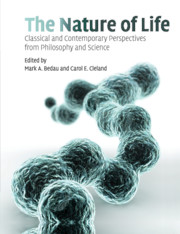Book contents
- Frontmatter
- Contents
- Preface
- Acknowledgments
- Sources
- About the authors
- Introduction
- SECTION I CLASSICAL DISCUSSIONS OF LIFE
- SECTION II THE ORIGIN AND EXTENT OF NATURAL LIFE
- SECTION III ARTIFICIAL LIFE AND SYNTHETIC BIOLOGY
- SECTION IV DEFINING AND EXPLAINING LIFE
- Supplementary bibliography on life
- Index
- References
SECTION II - THE ORIGIN AND EXTENT OF NATURAL LIFE
Published online by Cambridge University Press: 10 November 2010
- Frontmatter
- Contents
- Preface
- Acknowledgments
- Sources
- About the authors
- Introduction
- SECTION I CLASSICAL DISCUSSIONS OF LIFE
- SECTION II THE ORIGIN AND EXTENT OF NATURAL LIFE
- SECTION III ARTIFICIAL LIFE AND SYNTHETIC BIOLOGY
- SECTION IV DEFINING AND EXPLAINING LIFE
- Supplementary bibliography on life
- Index
- References
Summary
The chapters in this section discuss contemporary scientific views about two issues: how the familiar forms of life that exist on Earth originated from nonliving material by physico-chemical processes, and how familiar life forms might differ from other forms of life that naturally exist. Our scientific knowledge of natural life is limited to current life on Earth, which includes microbes (true bacteria, bacteria-like archea, and protists, e.g., paramecia) as well as larger, more familiar fungi (e.g., mushrooms), plants, and animals. For better or worse, our paradigm of life is founded upon these organisms because they represent the only examples of life of which we can be certain. Our understanding of life in general, including the possibilities for artificial life and extraterrestrial life, is strongly influenced by what biologists and biochemists have discovered about life on Earth. Moreover, by asking specific biological questions, deeper philosophical ones inevitably emerge. The import of these chapters is thus not limited to the topic of this section. Taken together, these chapters bring important and sometimes underappreciated discoveries in biology and biochemistry to bear on some of the oldest questions about life.
Philosophical questions inevitably arise as soon as one starts probing the origin and extent of natural life. Both scientific projects raise general philosophical questions about life, such as the following: What presuppositions about life are embedded in different views about how life arose or what forms could exist? What weight should we place on those presuppositions?
- Type
- Chapter
- Information
- The Nature of LifeClassical and Contemporary Perspectives from Philosophy and Science, pp. 113 - 120Publisher: Cambridge University PressPrint publication year: 2010



